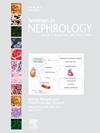患者对体外循环凝血的看法以及抗凝疗法的决策。
IF 2.8
3区 医学
Q2 UROLOGY & NEPHROLOGY
引用次数: 0
摘要
体外循环凝血是血液透析过程中的一种并发症,可导致透析疗程缺失或缩短、护理工作量增加以及治疗成本上升。透析不足的后果可能包括患者失血过多、体液超负荷、矿物质积聚、住院率升高以及生活质量下降,从而加重患者的痛苦。通过抗凝治疗预防凝血是保持透析回路通畅和支持透析充分性的关键。尽管患者在体外循环中会遇到凝血的严重后果,但他们对抗凝治疗决策的看法却鲜为人知。在本文中,我们将讨论患者对凝血和抗凝治疗的看法和优先考虑事项,并概述通过共同决策支持患者治疗的方法。了解患者对解决体外循环血栓并发症的看法可以为改善血液透析患者的护理和治疗效果提供参考。本文章由计算机程序翻译,如有差异,请以英文原文为准。
Patient Perspectives on Clotting in the Extracorporeal Circuit and Decision-Making Regarding Anticoagulation Therapy
Clotting of the extracorporeal circuit is a complication in the process of hemodialysis that can result in missed or shortened dialysis sessions, higher nursing workload, and elevated cost of treatment. Repercussions of inadequate dialysis may include patient blood loss, fluid overload, build-up of minerals, higher hospitalization rates, and poor quality of life, contributing to increased patient distress. Preventing clotting through anticoagulation therapy is the key to maintaining patency of the dialysis circuit and supporting dialysis adequacy. Despite the severe consequences of clotting in the extracorporeal circuit patients encounter, their perspectives on decision-making regarding anticoagulation therapy are not well known. In this article, we discuss patients’ perspectives and priorities around clotting and anticoagulation therapy and outline ways to support their treatment through shared decision-making. Insights into patients’ perspectives on addressing thrombotic complications of the extracorporeal circuit can inform strategies to improve care and outcomes for patients receiving hemodialysis.
求助全文
通过发布文献求助,成功后即可免费获取论文全文。
去求助
来源期刊

Seminars in nephrology
医学-泌尿学与肾脏学
CiteScore
5.60
自引率
0.00%
发文量
27
审稿时长
6-12 weeks
期刊介绍:
Seminars in Nephrology is a timely source for the publication of new concepts and research findings relevant to the clinical practice of nephrology. Each issue is an organized compendium of practical information that serves as a lasting reference for nephrologists, internists and physicians in training.
 求助内容:
求助内容: 应助结果提醒方式:
应助结果提醒方式:


